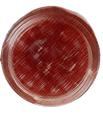
Common Problems:
Whole fruit rises to the top
of jar:
This happens if the mixture was too liquid and needed longer boiling.
Also make sure the cooked jam resst for a while in the pan to allow to
cool before bottling - say 15 minutes.
Crystallizes, forms a mould or
ferments:
This occurs when the equipment has not been properly sterilised before
preparing the preserves.
Fruit discolouration:
This happens if the preserve was cooked too long. To shorten cooking time
you can heat the sugar in the oven first.
Crystalises in refrigerator:
Keep jam in a cool place such as a larder or a dark shelf.
Ferments and goes fizzy:
Cooking time was too short or pectin, acid and sugar were not in the right
proportion. The temperature of 220ºF/105ºC must be reached or use the
wrinkle test for jell (setting) point: pour a few drops onto a cold surface
and wait for a moment to allow it to cool push it with your finger it
should wrinkle if setting point has been reached.
The keeping quality of Jam is largely determined by the set and the correct proportion of sugar, but even with high proportion of sugar jam may go mouldy if kept in a damp store. The type of cover used is also an important factor. A waxed disc pressed evenly on the surface of the jam while still hot, certainly prevents mould growth to a large extent and even if mould develops it rarely penetrates through the paper into the Jam.
Jams covered with parchment or cellulose paper keep better than those with metal covers lined with cardboard. Home-made covers such are best put on the jam at once when it is very hot.
Most commercial jams are sealed with airtight covers made of metal. Home made jam can be sealed in the same way but they must be sealed as soon as the jam is potted. A wax disc is unneccessary under seal and is in fact more important to cover the jam quickly.
Seals are a time saving method of storing jam but involve extra cost. Plastic seals press on lids are generally reusable and again must be placed immediately on the hot jam. They have the advantage in reducing shrinkage that might occur if the jam is stored in a centrally heated house.
Source MAFF
Sealing the jars in a boiling water canner produces a strong seal that should last at least one year. Sealing the jars by turning them upside down (as recommended by some pectin manufacturers) saves time on jelly-making day but results in a weaker seal that may fail during storage. Sealing the jars with paraffin wax is no longer recommended because too often the wax seperates from the side of the jars, allowing air to touch the jelly and mold is possible. Mistakes melting the paraffin also caused many kitchen fires and severe arm burns.
Source http://www.foodpres.com/

|
Jams, Jellies, Pickles & Preserves Helen Sudell Lorenz Books Paperback - 22 August, 1999 Avg. Customer Review: Usually dispatched in 2-3 days |
||||
|
|||||